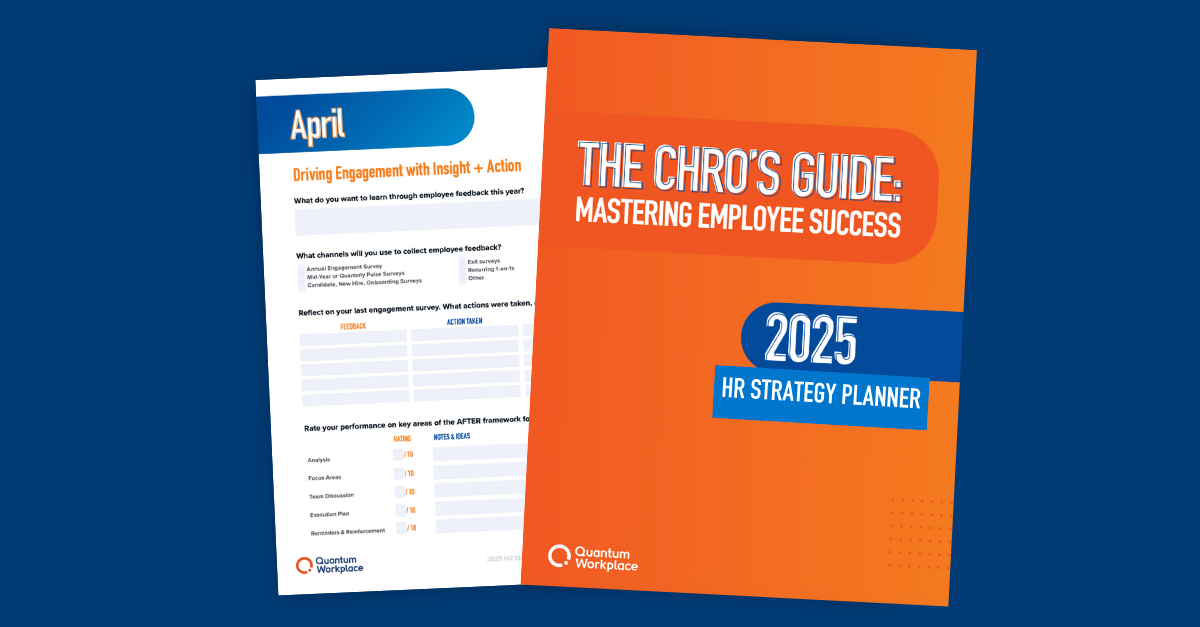HR as a Strategic Partner: The 2025 Planning Guide
When HR departments operate in a silo—and their programs are disconnected and misaligned with the business’ strategic goals—it's a missed opportunity for both HR and senior leadership.
In fact, 70% of CEOs expect their CHRO to be a key player in enterprise strategy, but only 55% say their CHRO meets this expectation.
HR is in a unique position to impact key performance indicators, including company culture and employee engagement. But without a strategic HR partner to guide those efforts, your impact will fall short.
In this article, we’ll cover exactly what it means to be a strategic partner in HR, why it’s important, and how you can build a strategic plan for your HR department this year.
What is a strategic HR partner
The role of HR as a strategic partner is to develop and direct an HR agenda that supports and drives the overarching goals of the organization.
In other words, a strategic HR partner bridges the gap between the work of the HR team on the ground and the mission of the C-suite.
To do this, strategic HR partners make sure that the HR policy, procedures, and governance align with the big picture. Strategic HR partners ask, "How can HR help create an engaging, high-performance culture that drives the whole business forward?"
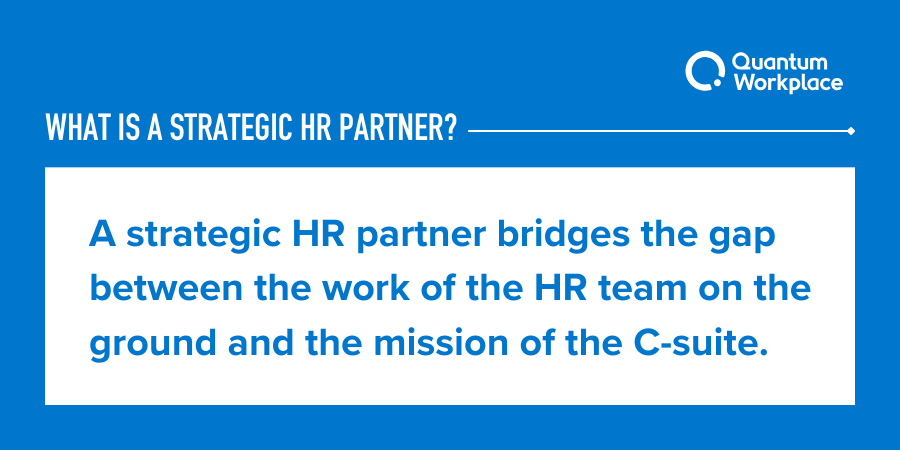
How to move from HR Tactics to HR Strategy
Transitioning from the tactical role of HR manager to that of a strategic HR partner is pivotal in today's dynamic business landscape. While both roles are vital, they serve distinct purposes within an organization.
The HR manager has long been the backbone of HR departments, overseeing the day-to-day operations, ensuring compliance, managing payroll, and handling recruitment. HR managers are essential for maintaining the smooth functioning of HR processes, but they primarily operate at a tactical level, focusing on the immediate needs of the workforce.
Becoming a strategic HR partner marks a significant shift in HR's function.
Instead of getting caught up in the minutiae of daily HR tasks, a strategic HR partner operates at a higher altitude, aligning HR initiatives with the overarching goals of the organization.
The roles of a strategic HR partner
Instead of getting caught up in the minutiae of daily HR tasks, a strategic HR partner operates at a higher altitude, aligning HR initiatives with the overarching goals of the organization.
Strategic Advisor
Strategic HR partners act as trusted advisors to top leadership. They leverage their deep understanding of HR and the organization to provide insights and guidance on strategic decisions. This includes talent acquisition strategies, workforce planning, and initiatives to improve employee engagement.
Problem Solver
They are adept at identifying and addressing complex workforce challenges. Whether it's resolving interdepartmental conflicts or devising innovative solutions for talent retention, strategic HR partners are the go-to problem solvers in the organization.
Mentor and Coach
Beyond managing HR processes, they invest time in nurturing talent within the HR team and across the organization. They mentor emerging HR professionals, helping them grow into future strategic partners themselves. Additionally, they coach managers on effective leadership and people management.
Independent Leader
While collaborating closely with HR departments, strategic HR partners maintain a degree of independence. This independence allows them to offer unbiased perspectives, ensuring that HR initiatives are aligned with the organization's best interests.
Alignment Driver
The primary goal of a strategic HR partner is to ensure that everyone within the organization is pulling in the same direction. They work closely with HR departments and the leadership team to align HR strategies with broader organizational goals, fostering a unified and purpose-driven workforce.
Strategic HR partners are the architects of HR strategy, contributing directly to the achievement of organizational objectives. By shifting the focus from tactical HR tasks to strategic HR initiatives, businesses can navigate the evolving needs of the workforce, foster innovation, and drive sustainable growth.
Embracing this transformation is not just a choice; it's a strategic investment in today's competitive business environment.
Why you should become a strategic HR partner
Too often, HR teams operate in a silo, disconnected from the conversations and decision making happening among senior leadership. This can create misalignment between HR and the rest of the business and hinders HR’s ability to support (and ultimately drive) strategic business outcomes.
Successful, high-performing organizations build alignment across teams and departments. And HR is uniquely positioned to enable and promote alignment when working together with senior leadership as a strategic partner.
HR is the glue that binds teams and organizations together—which means HR has the potential for high impact across the organization. From behind-the-scenes administration to internal communication, leadership training, and recruiting and onboarding programs, HR plays a critical role in company culture, employee engagement, and ultimately, business performance.
That’s where HR as a strategic partner can really make a difference for both HR efforts and overall business success. Strategic HR partners can help drive individual, team, and organizational performance using a variety of tactics.
1. Have CEOs refocus on talent strategies
Today's CEOs and senior leadership teams are increasingly recognizing the pivotal role of talent strategies in achieving organizational success. The need to attract, retain, and develop top talent has become paramount. HR, as the steward of talent management, needs to step into a strategic partnership to address this demand effectively.
2. Use workplace culture as a performance driver
Research from Quantum Workplace underscores the undeniable connection between culture and performance. High-performing organizations attribute their success to a culture that reflects their values and beliefs.
75% of high-performing organizations say that their organization's culture reflects their values and beliefs. 70% of high-performing organizations say that their organization's culture drives desired organizational outcomes and business results.
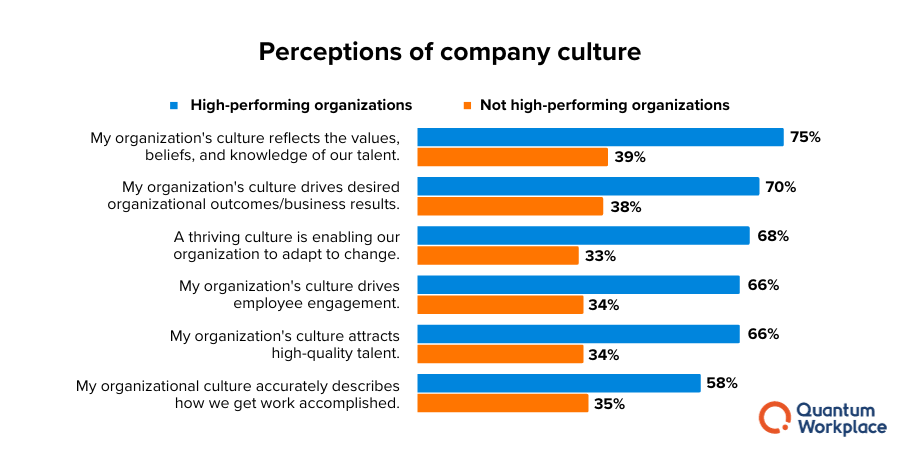
Such cultures drive desired organizational outcomes and business results. HR, as the cultural architect, plays a pivotal role in shaping this performance-enhancing culture.
3. Navigate complexity in the modern workplace
The contemporary workplace is a complex ecosystem, influenced by factors like globalization, technology, and shifting employee expectations. HR must evolve to navigate this complexity. As a strategic partner, HR can help organizations adapt, ensuring that their workforce remains agile, motivated, and aligned with strategic goals.
4. Performance and engagement are no longer in silos
The conventional approach of segregating performance and engagement strategies no longer suffices. Recent findings highlight a strong correlation between employee engagement, productivity, and performance.
Engaged employees lead to satisfied customers, a critical driver of business success.
Almost all respondents (92%) agree that organizations with highly engaged employees have happy customers, with 72% in strong agreement.
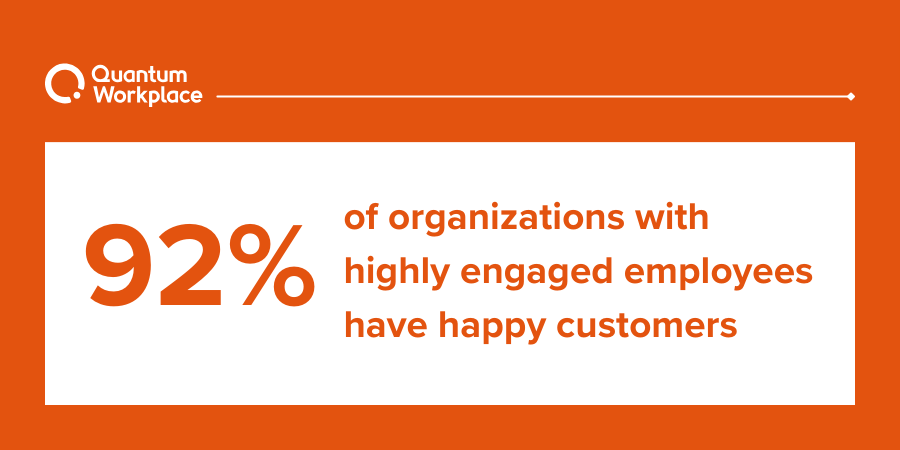
HR, as the curator of these strategies, must integrate them seamlessly to achieve these outcomes.
5. Rethink your organizational investments
Many organizations invest heavily in employee success with the primary goals of improving productivity and retention. However, according to Quantum Workplace research, only around a third have actually achieved these goals.
More than half of respondents say the primary business goals for their investments in employee success are to improve productivity and retention (53% and 52%, respectively). But only around a third have actually achieved these goals.
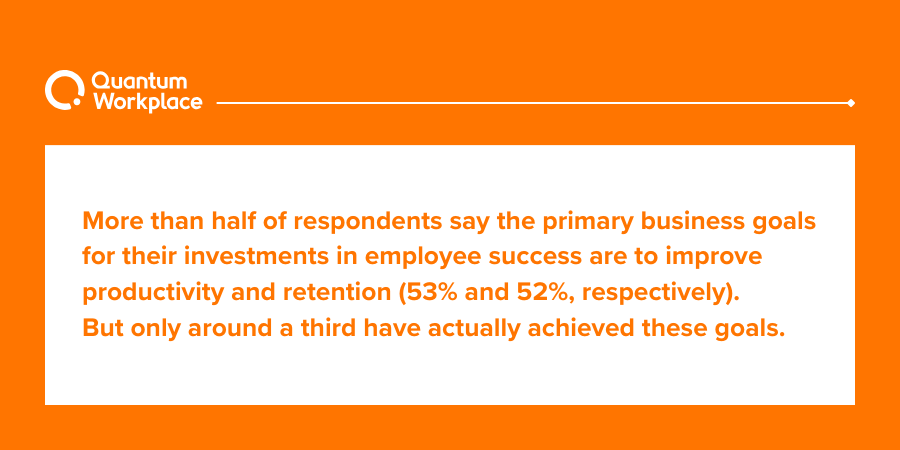
HR, as a strategic partner, can lead the way in reevaluating and redefining these investments to ensure they align with broader organizational objectives and drive the intended results.
And the need to invest is greater than ever.
According to Brandon Hall Group, a significant number of organizations express dissatisfaction with their current performance management processes.
62% state that these processes don't enhance performance, and 70% admit they don't drive employee engagement.
These figures underscore the urgent need for HR to step into the role of a strategic partner, revamping and realigning HR strategies for greater effectiveness.
6. Tie performance to your bottom line
In the competitive business landscape, every aspect of an organization contributes to its bottom line. HR, when operating as a strategic partner, becomes a catalyst for enhancing overall business performance.
By aligning HR efforts with organizational goals, HR not only positively impacts employee engagement and retention but also contributes significantly to the company's financial success.
What are the barriers to HR becoming a strategic partner?
It’s easy to encourage HR to become a strategic partner. But unfortunately, many organizations encounter barriers to success. In order to get the most impact from your HR team, you have to work to remove the most common barriers to success.
Employee Success Is Not Prioritized
In some organizations, the broader business strategy may not prioritize employee success and engagement. This misalignment can hinder HR's efforts to contribute strategically, as the overall corporate focus may not align with HR's objectives.
There’s a Resistance to Change
The resistance of teams and employees to embrace change is a common challenge. Even when HR introduces innovative solutions or strategies, the lack of buy-in and adoption from teams can impede progress. Some organizations may pressure HR to consolidate and make the most of existing technology and resources rather than investing in new solutions. While this approach can have merit, it may limit HR's ability to innovate and adapt to evolving challenges.
Outdated Processes and Technology
Outdated, manual, or siloed processes, along with obsolete HR tech, can create inefficiencies that bog down HR professionals. The time-consuming nature of managing these systems can hinder HR's ability to engage in more strategic endeavors. HR teams need tools and technologies that simplify their work and streamline processes. This requirement extends to solutions that not only benefit HR professionals but also make tasks easier for everyone in the organization, from managers to employees.
There’s a Fear of Added Chaos and Workload
HR professionals often operate in highly demanding and chaotic work environments. Balancing a long list of tasks, from recruitment and onboarding to policy enforcement, can leave limited bandwidth for strategic activities. HR teams may resist adopting new solutions because they fear these changes will add to their already overwhelming workload. The perception that new tools and strategies will demand more time and effort can be a significant barrier.
They Lack Managerial Support
HR can't do it all alone. To become strategic partners, HR professionals need strong support and involvement from managers. Without managers actively participating in initiatives, HR's efforts to drive change and improvement may face significant roadblocks.
These roadblocks can make it difficult to see the desired impact. Despite their best efforts, barriers may cause strategic investments to fall short of expectations, making it challenging to demonstrate their organizational value. As a result, strategic initiatives may get pushed further and further to the backburner. But there is hope!
Recognizing and addressing these barriers proactively and reactively is crucial for HR to evolve into a strategic partner.
How to become a strategic HR partner
While it may seem daunting, becoming a strategic HR partner really comes down to the right investment, the right leadership, and the right plan. While we may not be able to help you with the first two, our team of employee success experts put together a proven plan to help HR become a strategic partner.
Below, we outline a 12-month HR plan that you can easily customize for your organization. While the months below are designed to start in January, it’s never too late to start working on your plan to become a strategic HR partner.
Month 1:
Setting your intentions for a high-impact year
Start strong by aligning HR strategies with business goals. Identify the organization’s top priorities for 2025, connect them to HR initiatives, and solidify your role as a strategic business partner. Focus on understanding long-term goals and shaping an HR roadmap that supports measurable growth.
Dive into our 2025 HR Strategy Planner for more on this theme >>
Month 2:
Engagement & performance are better together
Break free from the pendulum swing between engagement and performance. Instead, focus on integrating these two elements to drive results and fuel a culture of continuous improvement. Evaluate your organization’s current priorities, and find ways to build a virtuous cycle between employee engagement and productivity.
Dive into our 2025 HR Strategy Planner for more on this theme >>
Month 3:
Moving on from status quo technology
Audit your current HR tech stack and assess whether it meets your engagement and performance needs. Consider how tools like AI can streamline manual processes, provide actionable insights, and empower HR leaders to operate more strategically. Invest in solutions that align people strategies with business outcomes.
Dive into our 2025 HR Strategy Planner for more on this theme >>
Month 4:
Driving engagement with insight & action
Employee surveys are just the beginning. The real impact comes from using feedback to spark meaningful action. Build a scalable action-planning process that turns survey insights into measurable change, engaging managers and employees in the process for stronger alignment and trust.
Dive into our 2025 HR Strategy Planner for more on this theme >>
Month 5:
Predicting & preventing top talent turnover
Unwanted turnover is costly, but with predictive analytics and employee listening strategies, you can stay ahead of the curve. Pinpoint at-risk employees, uncover true turnover drivers, and take proactive steps to retain your top talent by addressing their needs and aspirations.
Dive into our 2025 HR Strategy Planner for more on this theme >>
Month 6:
Navigating change management better
Prepare your organization for inevitable change by building resilience and trust. Equip managers and leaders to communicate effectively, align cultural efforts with strategic goals, and gather real-time feedback during transitions to minimize disruption and drive engagement.
Dive into our 2025 HR Strategy Planner for more on this theme >>
Month 7:
Creating pathways for employee development
Career growth is one of the strongest engagement drivers, yet it’s often overlooked. Create clear pathways for development by equipping managers to facilitate meaningful career conversations, offering upskilling opportunities, and ensuring alignment between employee aspirations and business needs.
Dive into our 2025 HR Strategy Planner for more on this theme >>
Month 8:
Unlocking manager effectiveness
Managers are the linchpins of engagement and performance. Empower them with the training, tools, and data they need to lead effectively. Simplify performance management processes, foster coaching skills, and make engagement actionable for every manager on your team.
Dive into our 2025 HR Strategy Planner for more on this theme >>
Month 9:
Achieving strategic alignment
Misalignment drains resources and slows progress. Ensure alignment by connecting employee goals to organizational strategy, equipping managers with tools to translate priorities into team objectives, and fostering a culture of accountability and collaboration.
Dive into our 2025 HR Strategy Planner for more on this theme >>
Month 10:
Performance management frameworks that work
Traditional performance management processes are falling short. Shift to frameworks that prioritize continuous feedback, align individual and organizational goals, and engage employees in their growth. Leverage tools and AI to simplify and enhance the performance review process.
Dive into our 2025 HR Strategy Planner for more on this theme >>
Month 11:
Syncing talent reviews & succession planning
Talent reviews and succession planning are essential to future-proofing your workforce. Build a scalable process to identify top talent, address gaps, and develop leaders who align with your organization’s long-term goals. Equip managers with the skills to drive meaningful development conversations.
Dive into our 2025 HR Strategy Planner for more on this theme >>
Month 12:
Equipping leaders to carry the torch on culture
HR alone can’t own culture—it’s a shared responsibility. Equip leaders to model desired behaviors, connect cultural priorities to business outcomes, and empower employees to contribute to a positive workplace environment. Make 2025 the year culture becomes a competitive advantage.
Dive into our 2025 HR Strategy Planner for more on this theme >>
Investing in impact: getting the most from strategic HR planning
In the ever-evolving landscape of HR, the road to success demands more than just good intentions. It requires strategic investments in impact—choices that drive meaningful change, engage your workforce, and empower your HR team.
The days of assumptions and guesswork are gone. Today, it's about confident decisions, data-backed insights, and targeted actions. It's about efficiency and simplicity, freeing your team from clunky tools and empowering them to be true coaches. It's about energizing partnerships that provide the support and expertise needed to propel your HR initiatives forward.
As you embark on this transformative journey, remember that your success hinges on these critical investments. The path to becoming a strategic HR partner, one who not only influences but drives your organization's success, lies in your ability to harness the power of impact.
To guide you through this strategic HR journey, we invite you to download our complete CHRO Strategic Planner.
This comprehensive, hands-on 12-month strategic HR planning guide will help you turn these principles into actionable strategies, paving the way for a future where HR isn't just a function but a force for positive change.
Don't wait—invest in impact today and lead the way to a more engaged, productive, and successful workforce.


